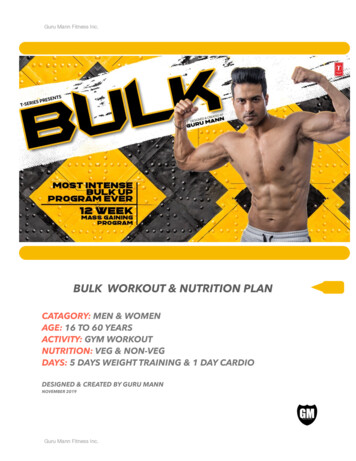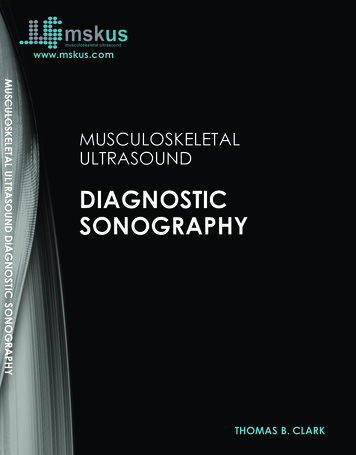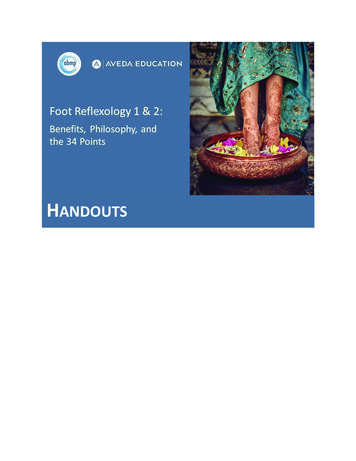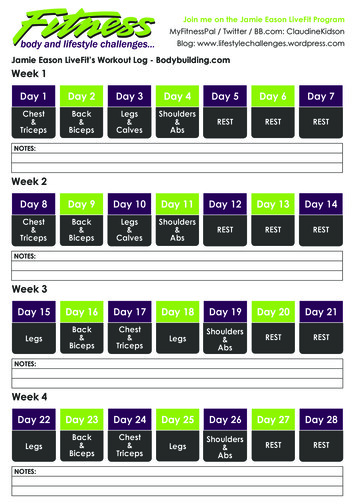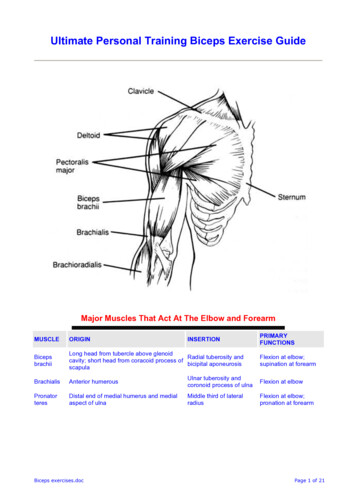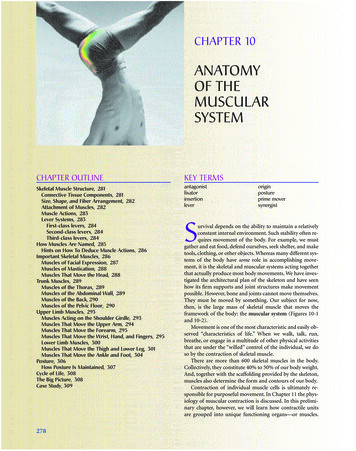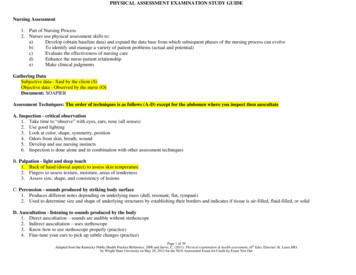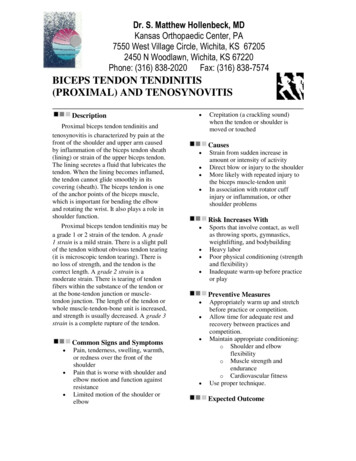
Transcription
Dr. S. Matthew Hollenbeck, MDKansas Orthopaedic Center, PA7550 West Village Circle, Wichita, KS 672052450 N Woodlawn, Wichita, KS 67220Phone: (316) 838-2020 Fax: (316) 838-7574BICEPS TENDON TENDINITIS(PROXIMAL) AND TENOSYNOVITISDescriptionProximal biceps tendon tendinitis andtenosynovitis is characterized by pain at thefront of the shoulder and upper arm causedby inflammation of the biceps tendon sheath(lining) or strain of the upper biceps tendon.The lining secretes a fluid that lubricates thetendon. When the lining becomes inflamed,the tendon cannot glide smoothly in itscovering (sheath). The biceps tendon is oneof the anchor points of the biceps muscle,which is important for bending the elbowand rotating the wrist. It also plays a role inshoulder function.Proximal biceps tendon tendinitis may bea grade 1 or 2 strain of the tendon. A grade1 strain is a mild strain. There is a slight pullof the tendon without obvious tendon tearing(it is microscopic tendon tearing). There isno loss of strength, and the tendon is thecorrect length. A grade 2 strain is amoderate strain. There is tearing of tendonfibers within the substance of the tendon orat the bone-tendon junction or muscletendon junction. The length of the tendon orwhole muscle-tendon-bone unit is increased,and strength is usually decreased. A grade 3strain is a complete rupture of the tendon. Common Signs and SymptomsPain, tenderness, swelling, warmth,or redness over the front of theshoulderPain that is worse with shoulder andelbow motion and function againstresistanceLimited motion of the shoulder orelbow Crepitation (a crackling sound)when the tendon or shoulder ismoved or touchedCauses Strain from sudden increase inamount or intensity of activityDirect blow or injury to the shoulderMore likely with repeated injury tothe biceps muscle-tendon unitIn association with rotator cuffinjury or inflammation, or othershoulder problemsRisk Increases With Sports that involve contact, as wellas throwing sports, gymnastics,weightlifting, and bodybuildingHeavy laborPoor physical conditioning (strengthand flexibility)Inadequate warm-up before practiceor playPreventive Measures Appropriately warm up and stretchbefore practice or competition.Allow time for adequate rest andrecovery between practices andcompetition.Maintain appropriate conditioning:o Shoulder and elbowflexibilityo Muscle strength andenduranceo Cardiovascular fitnessUse proper technique.Expected Outcome
Dr. S. Matthew Hollenbeck, MDKansas Orthopaedic Center, PAibuprofennot take within 7 days7550curableWestwithinVillageKS(do67205This condition is usually6 Circle, Wichita,before surgery), are used to reduceweeks if treated appropriatelywith N Woodlawn, Wichita, KS 672202450inflammation. Take these asconservative treatment and resting of thedirectedyour physician. ContactFax:(316)by838-7574affected area. HealingPhone:is usually (316)quicker838-2020ifcaused by a direct blow (versus overuse).Possible Complications Prolonged healing time if notappropriately treated or if not givenadequate time to healChronically inflamed tendoncausing persistent pain with activitythat may progress to constant pain(with or without activity), restrictionof motion of the tendon within thesheath (adhesive or constrictivetenosynovitis), and potentiallyrupture of the tendonRecurrence of symptoms, especiallyif activity is resumed too soon orwith overuse, a direct blow, or useof poor technique Heat and Cold General TreatmentConsiderationsInitial treatment consists of medicationand ice to relieve the pain, stretching andstrengthening exercises, and modification ofthe activity that initially caused the problem.These all can be carried out at home,although referral to a physical therapist orathletic trainer may be recommended. Aninjection of cortisone to the area around thetendon (within the sheath) may berecommended. Surgery to remove theinflamed tendon lining or to detach thedegenerated tendon and re-insert it into thearm bone is not usually necessary and isgenerally only considered after at least 6months of conservative treatment. Surgeryto correct other shoulder problems that maybe contributing to tendinitis may berecommended before surgery for thetendinitis itself.Medication Nonsteroidal anti-inflammatorymedications, such as aspirin andyour physician immediately if anybleeding, stomach upset, or signs ofan allergic reaction occur. Otherminor pain relievers, such asacetaminophen, may also be used.Pain relievers are usually notprescribed for this condition. Ifprescribed, use only as directed andonly as much as you need.Cortisone injections reduceinflammation, and anestheticstemporarily relieve pain. However,these are used only in extremecases; there is a limit to the numberof times cortisone may be givenbecause it may weaken muscle andtendon tissue. Cold is used to relieve pain andreduce inflammation for acute andchronic cases. Cold should beapplied for 10 to 15 minutes every 2to 3 hours for inflammation and painand immediately after any activitythat aggravates your symptoms. Useice packs or an ice massage.Heat may be used before performingstretching and strengtheningactivities prescribed by yourphysician, physical therapist, orathletic trainer. Use a heat pack or awarm soak.Notify Our Office If Symptoms get worse or do notimprove in 2 weeks despitetreatmentNew, unexplained symptomsdevelop (drugs used in treatmentmay produce side effects)
Dr. S. Matthew Hollenbeck, MDKansas Orthopaedic Center, PA7550 West Village Circle, Wichita, KS 672052450 N Woodlawn, Wichita, KS 67220Phone: (316) 838-2020 Fax: (316) 838-7574From Rockwood CA Jr., Matsen FA III: The Shoulder, 2nd ed. Philadelphia, WB Saunders, 1998, p. 70.RANGE OF MOTION AND EXERCISES Biceps Tendon (Proximal) and TenosynovitisThese are some of the initial exercises your rehabilitation program with until physician, physical therapist, orathletic until your symptoms are resolved. Please Flexible tissue is more tolerant of the on it during activities. Each stretch should be held for A gentle stretching sensation shouldSHOULDER Flexion1. Lie on your back. Grasp the bottom of a stick,handle of an umbrella, or blade of a golf clubin your hand as shown.2. Using the stick, raise your arm overhead asshown until you feel a gentle stretch. Leadwith the thumb in a “thumbs up” position.3. Repeat exercise 2 times, 2 times per day. Holdeach repetition 30 seconds.SHOULDER Flexion1. Lie on your back holding a stick in bothhands, keeping your hands shoulder-widthapart.2. Raise both hands over your head until youfeel a gentle stretch.3. Repeat exercise 2 times, 2 times per day. Holdeach repetition 30 seconds.
Dr. S. Matthew Hollenbeck, MDKansas Orthopaedic Center, PA7550 West Village Circle, Wichita, KS 672052450 N Woodlawn, Wichita, KS 67220Phone: (316) 838-2020 Fax: (316) 838-7574SHOULDER Internal RotationSHOULDER Flexion1. While standing near a wall as shown, slowly“walk” your fingers up the wall until you feela gentle stretch.2. Repeat exercise 2 times, 2 times per day. Holdeach repetition 30 seconds.1. Grasp a stick behind your back with bothhands as shown.2. Slide the stick up your back until you feel agentle stretch.3. Repeat exercise 2 times, 2 times per day. Holdeach repetition 30 seconds.SHOULDER Abduction1. Lie on your back holding a stick, umbrellahandle, or golf club in your hand as shown.The hand should be in the “thumbs up”position.2. Using the stick, slowly push your arm awayfrom your side and as far overhead as you canwithout pain. Push until you feel a gentlestretch.3. Repeat exercise 2 times, 2 times per day. Holdeach repetition 30 seconds.SHOULDER Internal Rotation1. Place your hand behind your back.2. Drape a towel over your opposite shoulderand grasp it with the hand that is behind yourback.3. Use the towel to gently pull your hand fartherup your back until you feel a gentle stretch.4. Repeat exercise 2 times, 2 times per day. Holdeach repetition 30 seconds.
Dr. S. Matthew Hollenbeck, MDKansas Orthopaedic Center, PA7550 West Village Circle, Wichita, KS 672052450N Woodlawn,KS 67220STRENGTHENINGEXERCISES BicepsWichita,Tendon Tendinitis (Proximal) and TenosynovitisThese are some of the Phone:initial exercisesyou838-2020may start your rehabilitationprogramwith until you see your(316)Fax: (316)838-7574physician, physical therapist, or athletic trainer again or until your symptoms are resolved. Please remember: Strong muscles with good endurance tolerate stress better. Do the exercises as initially prescribed by your physician, physical therapist, or athletic trainer.Progress slowly with each exercise, gradually increasing the number of repetitions and weight usedunder their guidance.STRENGTH Shoulder Flexion1. Stand holding a weight in yourhand as shown, or hold the rubber band/tubingas shown.2. Slowly raise your arm overhead as far as youcan in your pain free range of motion. Do notallow your shoulder to “shrug up” while doingthis exercise.3. Keep your hand in a “thumbs-up” position.4. Hold this position for 30 seconds and thenslowly return to the starting position.5. Repeat exercise 2 times, 2 times per day.STRENGTH Shoulder Flexion,Isometric1. While standing, raise your arm straightin front of your body as shown.2. Place the other hand on top of your arm andpush down. Do not allow your arm to move.Push as hard as you can without having anypain or moving the arm.3. Hold this position for 30 seconds and thenslowly return to the starting position.4. Repeat exercise 2 times, 2 times per day.STRENGTH Elbow Flexion1. Stand with your arm straight and your palmfacing forward.2. Bend the elbow as shown using apound weight or rubber band/tubing as shown.3. Hold this position for 30 seconds and thenslowly return to the starting position.4. Repeat exercise 2 times, 2 times per day.
Dr. S. Matthew Hollenbeck, MDKansas Orthopaedic Center, PA7550 West Village Circle, Wichita, KS 672052450 N Woodlawn, Wichita, KS 67220Phone: (316) 838-2020 Fax: (316) 838-7574STRENGTH Elbow Flexion,Isometric1. With your involved/injured arm on the bottomand the palm of that hand facing upward,assume the position shown.2. While resisting with the top hand, try to bendthe elbow of your involved/injured arm.3. Do not allow your elbow to move.4. Hold this position for seconds, thenrelax.5. Repeat exercise times, times perday.Copyright 2003, Elsevier Science (USA). AllRights Reserved.
Poor physical conditioning (strength and flexibility) Inadequate warm-up before practice or play Preventive Measures Appropriately warm up and stretch before practice or competition. Allow time for adequate rest and recovery between practices and competition. Maintain a
